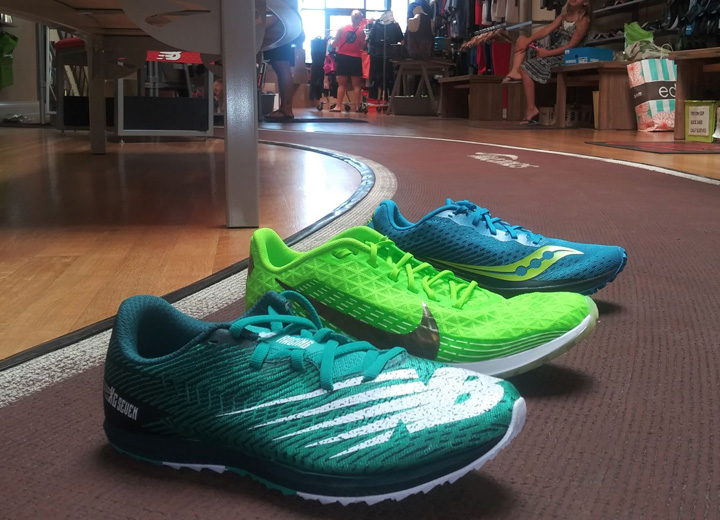At the RunningCo. of Haddonfield owner Dave Welsh carries a full lineup of cross-country and track spikes, including competition shoes for specialty events like the jumps and throwing events.
“The shot and disc shoes, we’ll sell upwards of 70 of those in a season,” says Welsh, who owns four RunningCo. shops in New Jersey. “It makes us unique and positions us to sell trainers, socks and shorts as well.”
While some run shops view cross-country and track and field competition shoes as a straightforward sell to a captive audience, others avoid spikes completely — just more inventory to track, they say.
Not Welsh, who considers spikes a valuable marketing play as well as a revenue booster.
“This is a customer for four years and it exposes us to the parents as well,” he says. “I’d rather commit marketing money to spikes than to an ad in the local paper.”
Ditto for running shops like Orlando-based Track Shack and Dick Pond Athletics in suburban Chicago. Both legacy operations are well known in their respective areas as the spots to visit for a deep assortment of competition shoes.
“We try to make sure we’re the resource for every runner in town, so why not have one more thing a customer can get from us?” Track Shack’s Chris Hughes says of the retail operation his parents founded in 1977. “Why send them to the Internet?”
While Hughes acknowledges that spikes and competition shoes do not drive the Track Shack business, the specialized footwear is nevertheless a rather no-nonsense sell and, even more, an important investment in the culture of the sport and its future.
“If we’re not investing in today’s athletes, then we’re failing ourselves long term,” he says.
Over the last 50 years, Dick Pond Athletics has largely built its business on catering to team athletes, including a robust inventory in competition shoes ranging from high-end sprint spikes to javelin shoes to close-out shoes for the discus.
“We’ll even have Division I schools with multimillion-dollar deals call us up looking for product because they can’t get it through their sponsor,” Dick Pond Athletics buyer Jim Stuart says.
The team business, Stuart continues, will remain a pillar of Dick Pond Athletics’ business model as it delivers an important point of differentiation in the competitive Chicago marketplace and helps propel awareness of the company’s five retail locations.
“Spikes legitimize us as a full-service running store, give us an opportunity to sell more product to our existing customers and provide us access to younger athletes that hopefully will become lifelong customers,” Stuart says.
Those appealing benefits, however, come at a cost. Principally, stores need to invest in product that consumes dollars and space. That often means redirecting investment from training shoes or another category like sandals or trail shoes.
Yet more, the only change between one model year and the next on a throwing shoe, for example, might be color. That makes the older year’s “version” a tough sell at MSRP and, most often, necessitates a markdown, especially as brands show a diminishing appetite for stock swaps.
“Even so, I’d still bet you’re going to make more money than you lose,” Hughes says.
When retailers find the right balance, though, the results can be powerful. During the recent track and field season, Welsh reports he had 88 percent sell-through on his Saucony spikes, a profitable gain for his running stores.
“But that’s because we’re super precise with our ordering,” Welsh says.
Of note, Welsh says many vendors are not building as much excess inventory, largely because spikes aren’t massive moneymakers for the brands. That translates into less opportunity for at-once orders and increased risk of disappointing customers. On the plus side, however, less inventory is flooding the market.
“Demand is there, supply is not,” Welsh says.
Finally, it’s worth noting that the presence of spikes can bring an overly competitive feel to a store. If only in perception, that vibe can heighten the intimidation factor run shops battle.
“That’s certainly something to be aware of,” Stuart acknowledges, adding that strategic in-store placement of competition shoes and off-site sales at schools and meets can help a running shop strike the right balance.
Selling Spikes
Six ways run shops are capturing the cross-country and track and field market.
#1: Be visible with product.
Like many others, Dick Pond Athletics visits track meets and schools to showcase and sell product. Online, the company’s website features its full assortment of in-stock goods, making competition product readily accessible to anyone searching it out.
“And that’s important because it might not be at their local running store.” Dick Pond’s Jim Stuart says.
#2: Spread the word.
With every spike purchase, RunningCo. of Haddonfield hands out a spike bag, one owner Dave Welsh had printed in a variety of colors aligning with local schools.
“And as kids are out walking around meets, that bag’s a marketing tool for us,” he says.
#3: Dangle a carrot.
An incentive can help move the needle with the team athlete crowd. Track Shack provides athletes a discount on their spike purchases, often in the 10-15 percent range, while Welsh places a coupon on the race bibs of major scholastic invites in his area to entice visits. Dick Pond Athletics’ Team Bucks program takes a different approach, directing a percentage of each team athlete purchase back to the athlete’s program. That move inspires coaches to send their athletes to one of Dick Pond’s five Chicago area stores.
#4: Know the influencers.
Speaking of coaches, they’re key influencers in this game. Track Shack engages local coaches with personal notes, while Dick Pond Athletics sends print catalogs to high school and college coaches across the U.S. as well as notes to every coach who has earned a Team Bucks reward.
“The number one thing is getting in with coaches and having them believe and support your business,” Welsh says. “Kids listen to their coaches.”
#5: Train staff.
Though spikes are a rather straightforward sell, staff must still know technical features and understand product scope. A sprint spike, for example, can do double-duty for the long jump, while a high jump shoe is far more event-specific and a mid-distance spike can function as a jack-of-all-trades shoe for multiple events.
“You need to develop a reputation that you know what you’re talking about,” Track Shack’s Chris Hughes says.
#6: Create a compelling environment.
When Welsh redid his store six years ago, he incorporated a four-lane track surface for athletes to test spikes as well as a brick wall and metal bleachers reminiscent of the Penn Relays. When he took over his building’s basement five years ago, he then created a dynamic, inviting spot for coaches and teams to gather.







